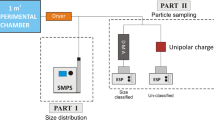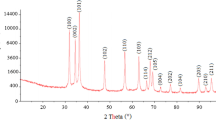Abstract
The study aims to bring more knowledge about risk assessments of paint aerosol exposure to the human body. Raw manufactured nanomaterials (MNMs), either titanium dioxide or carbon black, were introduced into water-based paint formations. The evaluation of the acute and subacute potential toxicity of these samples in a whole-body (mice) exposure model was performed. Inhalation aspects are especially regarded and description of the results obtained from each characterization stage of paint materials (raw MNMs, suspensions of MNMs, paint containing them and paint aerosol produced) is reported. Several techniques such as X-ray photoelectron spectroscopy, centrifugal liquid sedimentation, transmission electron microscopy, scanning electron microscopy, energy-dispersive X-ray spectroscopy and electrical low impactor were used to this objective. The modification of physicochemical properties of MNMs, incorporated into paint formulation before and after atomization process, was shown. The evidence of MNMs agglomerates inside micro-sized paint droplets in the overspray was highlighted and findings revealed that MNMs are strongly embedded into the paint matrix. This behavior indicates that minor or no potential toxicity exerted by MNMs in this type of complex products may be observed.









Similar content being viewed by others
References
Al-Kattan A, Wichser A, Zuin S, Arroyo Y, Golanski L, Ulrich A, Nowack B (2014) Behavior of TiO2 released from nano-TiO2-containing paint and comparison to pristine nano-TiO2. Environ Sci Technol 48:6710–6718
Al-Kattan A et al (2015) Characterization of materials released into water from paint containing nano-SiO2. Chemosphere 119:1314–1321
Allouni ZE, Gjerdet NR, Cimpan MR, Høl PJ (2015) The effect of blood protein adsorption on cellular uptake of anatase TiO2 nanoparticles. Int J Nanomed 10:687
Appleton E, Williams D (1987) Spray painting applications. Industrial robot applications. Springer, New York, pp 187–201
Arick DQ, Choi YH, Kim HC, Won Y-Y (2015) Effects of nanoparticles on the mechanical functioning of the lung. Adv Colloid Interface Sci 225:218–228
Baan RA (2007) Carcinogenic hazards from inhaled carbon black, titanium dioxide, and talc not containing asbestos or asbestiform fibers: recent evaluations by an IARC Monographs Working Group. Inhal Toxicol 19:213–228
Baisch BL, Corson NM, Wade-Mercer P, Gelein R, Kennell AJ, Oberdörster G, Elder A (2014) Equivalent titanium dioxide nanoparticle deposition by intratracheal instillation and whole body inhalation: the effect of dose rate on acute respiratory tract inflammation. Part Fibre Toxicol 11:5
Bermudez E, Mangum JB, Wong BA, Asgharian B, Hext PM, Warheit DB, Everitt JI (2004) Pulmonary responses of mice, rats, and hamsters to subchronic inhalation of ultrafine titanium dioxide particles. Toxicol Sci 77:347–357
Bourdon JA et al (2012) Carbon black nanoparticle instillation induces sustained inflammation and genotoxicity in mouse lung and liver. Part Fibre Toxicol 9:5
Camargo PH, Rodrigues TS, da Silva AG, Wang J (2015) Controlled synthesis: nucleation and growth in solution. Metallic nanostructures. Springer, Cham, pp 49–74
Carlton GN, Flynn MR (1997) A model to estimate worker exposure to spray paint mists. Appl Occup Environ Hyg 12:375–382
Clift MJ et al (2008) The impact of different nanoparticle surface chemistry and size on uptake and toxicity in a murine macrophage cell line. Toxicol Appl Pharmacol 232:418–427
De Jong WH, Borm PJ (2008) Drug delivery and nanoparticles: applications and hazards. Int J Nanomed 3:133
De Temmerman P-J, Lammertyn J, De Ketelaere B, Kestens V, Roebben G, Verleysen E, Mast J (2014) Measurement uncertainties of size, shape, and surface measurements using transmission electron microscopy of near-monodisperse, near-spherical nanoparticles. J Nanopart Res 16:2177
Donaldson K, Li X, MacNee W (1998) Ultrafine (nanometre) particle mediated lung injury. J Aerosol Sci 29:553–560
Donaldson K et al (2002) The pulmonary toxicology of ultrafine particles. J Aerosol Med 15:213–220
Drescher D, Orts-Gil G, Laube G, Natte K, Veh RW, Österle W, Kneipp J (2011) Toxicity of amorphous silica nanoparticles on eukaryotic cell model is determined by particle agglomeration and serum protein adsorption effects. Anal Bioanal Chem 400:1367
Elder A, Gelein R, Finkelstein JN, Driscoll KE, Harkema J, Oberdörster G (2005) Effects of subchronically inhaled carbon black in three species. I. Retention kinetics, lung inflammation, and histopathology. Toxicol Sci 88:614–629
European Commission (2010) Directive 2010/63/EU of the European Parliament and of the Council of 22 September 2010 on the protection of animals used for scientific purposes. Off J Eur Union. L 276/33
Flynn MR, Sills ED (2000) On the use of computational fluid dynamics in the prediction and control of exposure to airborne contaminants—an illustration using spray painting. Ann Occup Hyg 44:191–202
Ghosh Chaudhuri R, Paria S (2011) Core/shell nanoparticles: classes, properties, synthesis mechanisms, characterization, and applications. Chem Rev 112:2373–2433
Gilliland D, Gibson N, Hempelmann U (2014) JRC technical reports. Basic comparison of particle size distribution measurements of pigments and fillers using commonly available industrial methods. Institute for Health and Consumer Protection, Joint Research Centre, European Union, Report EUR 26916 EN (ISBN 978-92-79-43974-2)
Gilmour PS et al (2004) Pulmonary and systemic effects of short-term inhalation exposure to ultrafine carbon black particles. Toxicol Appl Pharmacol 195:35–44
Golanski L, Gaborieau A, Guiot A, Uzu G, Chatenet J, Tardif F (2011) Characterization of abrasion-induced nanoparticle release from paints into liquids and air. J Phys Conf Ser 1:012062 (IOP Publishing)
Grassian VH, Adamcakova-Dodd A, Pettibone JM, O’shaughnessy PI, Thorne PS (2007) Inflammatory response of mice to manufactured titanium dioxide nanoparticles: comparison of size effects through different exposure routes. Nanotoxicology 1:211–226
Gupta AK, Gupta M (2005) Synthesis and surface engineering of iron oxide nanoparticles for biomedical applications. Biomaterials 26:3995–4021
Gustafsson Å, Lindstedt E, Elfsmark LS, Bucht A (2011) Lung exposure of titanium dioxide nanoparticles induces innate immune activation and long-lasting lymphocyte response in the Dark Agouti rat. J Immunotoxicol 8:111–121
Hagendorfer H et al (2010) Size-fractionated characterization and quantification of nanoparticle release rates from a consumer spray product containing engineered nanoparticles. J Nanopart Res 12:2481–2494
Ji Z et al (2010) Dispersion and stability optimization of TiO2 nanoparticles in cell culture media. Environ Sci Technol 44:7309–7314
Jiang J, Oberdörster G, Biswas P (2009) Characterization of size, surface charge, and agglomeration state of nanoparticle dispersions for toxicological studies. J Nanopart Res 11:77–89
Jittu A, Munteanu R (2015) The physics behind the mechanisms of: atomization, electrostatic charging and paint particles transport with focus in the indirect charged bell. Acta Electroteh 56(5):245–249
Johnston HJ, Hutchison GR, Christensen FM, Peters S, Hankin S, Stone V (2009) Identification of the mechanisms that drive the toxicity of TiO2 particulates: the contribution of physicochemical characteristics. Part Fibre Toxicol 6:33
Jørgensen RB, Hveding IG, Solheim K (2017) Nano-sized emission from commercially available paints used for indoor surfaces during drying. Chemosphere 189:153–160
Kaegi R et al (2010) Release of silver nanoparticles from outdoor facades. Environ Pollut 158:2900–2905
Kaiser J-P, Zuin S, Wick P (2013a) Is nanotechnology revolutionizing the paint and lacquer industry? A critical opinion. Sci Total Environ 442:282–289
Kaiser J, Diener L, Wick P (2013b) Nanoparticles in paints: a new strategy to protect façades and surfaces? J Phys Conf Ser 1:012036 (IOP Publishing)
Koponen I, Jensen K, Schneider T (2009) Sanding dust from nanoparticle-containing paints: physical characterisation. J Phys Conf Ser 1:012048 IOP Publishing
Laloy J, Lozano O, Alpan L, Masereel B, Toussaint O, Dogné J, Lucas S (2015) Limited inflammatory response in rats after acute exposure to a silicon carbide nanoaerosol. J Nanopart Res 17:346
Lin S, Reitz R (1998) Drop and spray formation from a liquid jet. Annu Rev Fluid Mech 30:85–105
Linsinger T, Roebben G, Gilliland D, Calzolai L, Rossi F, Gibson N, Klein C (2012) JRC reference reports. Requirements on measurementsthe for the implementation of the European Commission definition of the term “nanomaterial”. Institute for Reference Materials and Measurements, Joint Research Centre, European Union, Report EUR 25404 EN (ISBN 978-92-79-25602-8)
Lövestam G, Rauscher H, Roebben G, Klüttgen BS, Gibson N, Putaud J-P, Stamm H (2010) JRC reference reports. Considerations on a definition of nanomaterial for regulatory purposes. Institute for Health and Consumer Protection, Institute for Reference Materials and Measurements, Institute for Environment and Sustainability, Joint Research Centre, European Union, Report EUR 24403 EN (ISBN 978-92-79-16014-1)
Lozano O, Mejia J, Tabarrant T, Masereel B, Dogné J-M, Toussaint O, Lucas S (2012) Quantification of nanoparticles in aqueous food matrices using particle-induced X-ray emission. Anal Bioanal Chem 403:2835–2841
Lucas E et al (2001) Nanocrystalline metal oxides as unique chemical reagents/sorbents. Chem Eur J 7:2505–2510
Lundqvist M et al (2011) The evolution of the protein corona around nanoparticles: a test study. ACS Nano 5:7503–7509
Maiorano G, Sabella S, Sorce B, Brunetti V, Malvindi MA, Cingolani R, Pompa PP (2010) Effects of cell culture media on the dynamic formation of protein—nanoparticle complexes and influence on the cellular response. ACS Nano 4:7481–7491
Maynard AD, Kuempel ED (2005) Airborne nanostructured particles and occupational health. J Nanopart Res 7:587–614
Mejia J et al (2011) Effects of the dispersion methods in Pluronic F108 on the size and the surface composition of MWCNTs and their implications in toxicology assessment. J Nanopart Res 13:655–667
Mejia J et al (2012) Are stirring and sonication pre-dispersion methods equivalent for in vitro toxicology evaluation of SiC and TiC? J Nanopart Res 14:815
Monteiller C, Tran L, MacNee W, Faux S, Jones A, Miller B, Donaldson K (2007) The pro-inflammatory effects of low-toxicity low-solubility particles, nanoparticles and fine particles, on epithelial cells in vitro: the role of surface area. Occup Environ Med 64:609–615
Nel AE et al (2009) Understanding biophysicochemical interactions at the nano–bio interface. Nat Mater 8:543–557
Nurkiewicz TR, Porter DW, Hubbs AF, Cumpston JL, Chen BT, Frazer DG, Castranova V (2008) Nanoparticle inhalation augments particle-dependent systemic microvascular dysfunction. Part Fibre Toxicol 5:1
Oberdörster G (2000) Pulmonary effects of inhaled ultrafine particles. Int Arch Occup Environ Health 74:1–8
Oberdörster G, Ferin J, Lehnert BE (1994) Correlation between particle size, in vivo particle persistence, and lung injury. Environ Health Perspect 102:173
Oberdörster G et al (2005) Principles for characterizing the potential human health effects from exposure to nanomaterials: elements of a screening strategy. Part Fibre Toxicol 2:8
Pilotek S, Tabellion F (2005) Nanoparticles in coatings. Eur Coat J 4:170–179
Piret J-P, Mejia J, Lucas S, Zouboulis CC, Saout C, Toussaint O (2014) Sonicated and stirred copper oxide nanoparticles induce similar toxicity and pro-inflammatory response in N-hTERT keratinocytes and SZ95 sebocytes. J Nanopart Res 16:2337
Rossi EM et al (2009) Airway exposure to silica-coated TiO2 nanoparticles induces pulmonary neutrophilia in mice. Toxicol Sci 113:422–433
Saber AT et al (2012) Inflammatory and genotoxic effects of nanoparticles designed for inclusion in paints and lacquers. Nanotoxicology 6:453–471
Schick RJ (2006) Spray technology reference guide: understanding drop size. Number Bull 459:8–16
Smulders S et al (2014) Toxicity of nanoparticles embedded in paints compared with pristine nanoparticles in mice. Toxicol Sci 141:132–140
Tolman RC (1949) The effect of droplet size on surface tension. J Chem Phys 17:333–337
Vorbau M, Hillemann L, Stintz M (2009) Method for the characterization of the abrasion induced nanoparticle release into air from surface coatings. J Aerosol Sci 40:209–217
Warheit DB, Webb TR, Reed KL, Frerichs S, Sayes CM (2007) Pulmonary toxicity study in rats with three forms of ultrafine-TiO2 particles: differential responses related to surface properties. Toxicol 230:90–104
Xia T et al (2013) Interlaboratory evaluation of in vitro cytotoxicity and inflammatory responses to engineered nanomaterials: the NIEHS Nano GO Consortium. Environ Health Perspect 121:683
Yang W, Peters JI, Williams RO (2008) Inhaled nanoparticles—a current review. Int J Pharm 356:239–247
Zuin S, Gaiani M, Ferrari A, Golanski L (2014) Leaching of nanoparticles from experimental water-borne paints under laboratory test conditions. J Nanopart Res 16:2185
Acknowledgements
This work was supported by SIINN-ERANET and by the Service Public de Wallonie (SPW)—Direction générale opérationnelle—Economie, Emploi et Recherche (DGO6), Département des Programmes de Recherche (NanoGeco Project, SPW/UNamur Research Convention N° 1318228) and by. The authors wish to thank the society RD Coatings Dothee for providing paint samples (containing or not MNMs).
Author information
Authors and Affiliations
Corresponding author
Additional information
Publisher's Note
Springer Nature remains neutral with regard to jurisdictional claims in published maps and institutional affiliations.
Rights and permissions
About this article
Cite this article
Fichera, O., Alpan, L., Laloy, J. et al. Characterization of water-based paints containing titanium dioxide or carbon black as manufactured nanomaterials before and after atomization. Appl Nanosci 9, 515–528 (2019). https://doi.org/10.1007/s13204-019-01030-4
Received:
Accepted:
Published:
Issue Date:
DOI: https://doi.org/10.1007/s13204-019-01030-4




